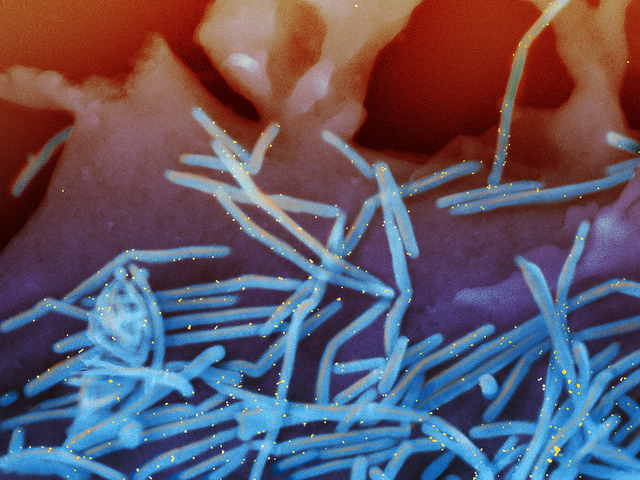Difference Between RSV and Bronchiolitis
Key Difference – RSV vs Bronchiolitis
Most children experience respiratory tract infections frequently during their childhood. Although a majority of these infections are self-limiting, some infections like bronchiolitis and pneumonia have the potential to become life threatening conditions. Bronchiolitis is the commonest serious infection that occurs during the infancy. In 80% of the cases, the causative agent of bronchiolitis is RSV. It can be also caused by influenza, parainfluenza, adenovirus, rhinovirus, human metapneumovirus, and Mycoplasma pneumonia. Thus, the key difference between RSV and bronchiolitis is that RSV is a pathogen whereas bronchiolitis is a disease that is mainly caused by RSV.
CONTENTS
1. Overview and Key Difference
2. What is RSV
3. What is Bronchiolitis
4. Side by Side Comparison – RSV vs Bronchiolitis in Tabular Form
5. Summary
What is RSV?
RSV is a virus of Paramyxoviridae family. Paramyxoviridae replicates in the upper respiratory tract and causes distinctly different illnesses. Usually, in the viruses of this family, hemagglutinins and neuraminidase are a part of the same glycoprotein spike but in RSV, both hemagglutinin and neuraminidase are absent.
RSV has a considerable strain variation and is usually categorized into two subgroups as subgroup A and B. Both subgroups may circulate in the community simultaneously resulting in epidemics. Outbreaks of RSV usually occur during the winter.

Figure 01: Electron micrograph of RSV virions (blue)
Viral Morphology
- Has negative single stranded RNA,
- Usually, 7-8 segments of RNA are found
- Has a helical symmetry,
- Envelope contains lipids
- Replication takes place in the nucleus
RSV is a highly contagious agent that accounts for the majority pneumonia cases among infants. In addition to the bronchiolitis, it causes croup and common cold as well. Contraction of RSV only once does not make the patient completely immune to the disease but the partial immunity acquired helps to limit the infection to the upper respiratory tract during the subsequent infections. Infants with congenital heart diseases, underlying pulmonary diseases, and a weak immune system are at a higher risk of severe infection.
Treatment
What is Bronchiolitis?
Bronchiolitis is the inflammation of the bronchioles which is associated with edema and the accumulation of cell debris and mucus in the bronchioles. This pathology of bronchioles results in over inflation, atelectasis, air trapping, and ventilation-perfusion mismatch. Bronchiolitis is the commonest respiratory tract infection among the infants. RSV is the main causative agent of bronchiolitis. Other pathogens such as influenza, parainfluenza, adenovirus, rhinovirus, human metapneumovirus, and Mycoplasma pneumonia can also cause this disease.

Figure 02: Atelectasis
Infants are more prone to get airway obstructions because of the smaller airways, increased collapsibility of the airways and the difference in tracheal rings. Male gender, overcrowding, babies who are not breast fed, infants of young mothers and maternal smoking are risk factors for the development of bronchiolitis.
Clinical Features
An affected child may have a contact history of a minor respiratory syndrome to an older child or an adult. Upper respiratory tract symptoms like rhinorrhea and sneezing can be seen. Coryzal symptoms may lead to a dry cough and dyspnea. The child may become febrile and anorexic. Respiratory distress can be identified by tachypnea, increased respiratory effort, nasal flaring, tracheal tugging, subcostal & intercostal recesses and excessive use of the accessory muscles.
On examination of the patient fine-end inspiratory crackles, high-pitched wheezes, tachycardia, cyanosis or pallor can be identified.
Diagnosis
In uncomplicated patients, diagnosis can be made solely depending on the clinical signs and symptoms. PCR analysis of nasopharyngeal secretions can also be helpful. If a chest X-ray is done, patchy atelectasis and hyperinflation due to smaller airway obstruction can be observed. Pulse oximetry is used to monitor the arterial oxygen saturation.
Management
Mainstay is the supportive management. The patient can be propped up. Humidified oxygen can be delivered through a nasal cannula. IV fluids are given. Oral and nasal secretions are sucked out to make the child comfortable.
Specific antiviral agents like Ribavirin are used for patients with CLD and CHD. Adjunct therapies like nebulization with salbutamol/ipratropium, steroids, hypertonic saline, and adrenaline have not been identified to be beneficial in reducing the severity and duration of the disease.
Most infants fully recover within 2 weeks from the beginning of the infection. Some may have a recurrent cough and wheeze. Rarely, in adenovirus infection, permanent damage to the airways (bronchiolitis obliterans) may occur.
Prevention
- As RSV is highly contagious, good hand hygiene methods should be practiced.
- The infection can be prevented by RSV immunoglobulin and Palivizumab.
What is the Difference Between RSV and Bronchiolitis?
RSV vs Bronchiolitis | |
| RSV (Respiratory syncytia virus) is a virus of Paramyxoviridae family. | Bronchiolitis is an acute inflammatory injury of the bronchioles that is usually caused by a viral infection |
| Relationship | |
| RSV is a pathogen. | Bronchiolitis is the disease caused by the RSV. |
Summary – RSV vs Bronchiolitis
Bronchiolitis is an acute inflammatory injury of the bronchioles that is usually caused by a viral infection. The virus responsible for the majority of cases of bronchiolitis is RSV. Thus, the main difference between RSV and bronchiolitis is that bronchiolitis is a disease whereas RSV is the pathogen mainly responsible for causing this disease.
Download PDF Version of RSV vs Bronchiolitis
You can download PDF version of this article and use it for offline purposes as per citation note. Please download PDF version here Difference Between RSV and Bronchiolitis.
Reference:
1. Lissauer, T., and Graham Clayden. “Illustrated textbook of Paediatrics 2001.” An imprint of Hurcowt Publishers Limited, UK: 222.
2. Gladwin, Mark. “Clinical Microbiology Made Ridiculously Simple 5th ed. Miami, FL: MedMaster.” (2011): 67.
Image Courtesy:
1. “Human Respiratory Syncytial Virus (RSV)” by NIAID (CC BY 2.0) via Flickr
2. “Atelectasis” By BruceBlaus – Own work (CC BY-SA 4.0) via Commons Wikimedia
ncG1vNJzZmivp6x7pbXFn5yrnZ6YsqOx07CcnqZemLyue8OinZ%2Bdopq7pLGMm5ytr5Wau26%2B0q9kmqaUYsO0ecGrpqebmJ68rbXToqpo